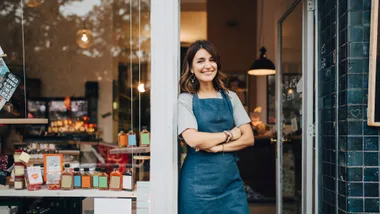Imagine if clocking in for work meant confronting massive spiders and angry snakes, hovering eight metres above the ground without a safety harness, or sneaking across international check points in places like Syria to cover war. We meet three Australian women chasing danger for good reason.
Tracey Shelton is a conflict reporter in the Middle East and North Africa for world news site Global Post. She has just left Turkey after covering the mine collapse.
When did you realise you wanted to be a photojournalist?
I’d always wanted to be an aid worker but was disillusioned by the extreme corruption and waste I saw within the multi-billion dollar aid business. My interest in media was a desire to expose this and look for ways to help people.
I started with photojournalism and moved into writing and video, and went from covering riots and border clashes in Cambodia to living in war zones in the Middle East.
What do you love most about your job?
I can tell the stories of people who would otherwise be ignored or forgotten. It is an immense privilege to be welcomed into the homes of people living under the most trying of circumstances and witness the incredible human ability to adapt.
It never ceases to amaze me how people manage to carve out a life in any situation, no matter how bad. Facing constant bombardment, in homes without power or water, trapped in a city under siege — you wouldn’t believe how soon you find yourself amongst it all, drinking tea and having a laugh with the local women or a ragtag bunch of rebel fighters.
What is the most dangerous situation you have found yourself in?
There have been many. I was badly beaten in a kidnapping attempt in Benghazi during the Libyan revolution. A group of men in army uniforms broke into my hotel room at 3am with guns and knives. I was tied up but escaped by getting my hands free and jumping across to a neighbouring balcony.
What are you working on at the moment?
Today I’m in Iraq attending an honour killing case. I’m looking at how certain laws throughout the world allow honour killers to either walk free or receive light sentencing rather than being tried for murder.
*Alisha Smith, is director of Integral Aerial Arts and is an aerialist.**?*
When did you discover aerial silk performance work?
I saw my first Cirque Du Soleil show in Las Vegas 10 years ago, and was captivated by the strength, grace and fearlessness of the aerial performers. Coming from the fitness industry, I had a massive appreciation of what it took for them to be able to do what they did.
What do you love most about your job?
I’ve always embraced the saying “Feel the fear and do it anyway”, so learning to conquer the fear and incredible physical challenge of being an aerialist have been huge accomplishments. Helping our students achieve the same things is also rewarding.
What is the most dangerous situation you have found yourself in?
While we take significant safety precautions, ultimately, I’m hanging from my hands or feet up to eight metres above the ground, manoeuvring my bodyweight without any safety net or harness.
I’ve been caught hanging from the silk by one arm, with it wrapped around my upper arm like a tourniquet, and I’ve sustained whiplash. But, injuries are few and far between, as we train to safely withstand the physical demands.
Are you afraid of heights?
No, but there is a fear the first time you perform or attempt a new trick. We do have people who come to our Sydney classes specifically to overcome their fear of heights, though.
Josie Stokes is a conservation biologist based in NSW, specialising in terrestrial biodiversity.
What do you love most about your job?
I love being in the great outdoors. I’m lucky to see to some remarkable interactions in nature that most people will never get to see.
Most importantly, the policies I write, advice I provide and my field work help minimise the impact of infrastructure on our native flora and fauna. Just knowing I can make a difference for future generations gets me out of bed every morning!
What is the most dangerous situation you have found yourself in?
Whenever I head out into the field, there is a 90 percent chance I’ll run into something dangerous or that wants to kill me. The scariest was my first venomous snake rescue.
A six-foot tiger snake had been trapped for over 24 hours at the top of automatic sliding doors to the Ba’hai temple at Ingleside. Every time the doors opened they would slam onto the snake’s head, so it was pretty annoyed by the time I arrived.
I had to climb a ladder, grab the snake by the tail and unravel it from obstruction (while juggling my catching bag and my balance). It was something out of a Steve Irwin show.
Pic by Tracey Shelton; a rebel fighter fires a missile across the Libyan frontline in Sirte, Libya, October 2011.





.jpg?resize=380%2C285)
.png?resize=380%2C285)
.jpg?resize=380%2C285)


